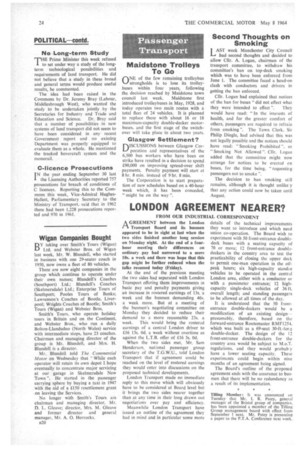LONDON AGREEMENT NEARER?
Page 26

If you've noticed an error in this article please click here to report it so we can fix it.
FROM OUR INDUSTRIAL CORRESPONDENT
AGREEMENT between the London I-1 Transport Board and its busmen appeared to be in sight at last when the two sides finished another long session on Monday night. At the end of a fourhour meeting their differences on ordinary pay had narrowed to a mere lbs. a week and there was hope that this gap might be further reduced when the talks resumed today (Friday).
At the end of the previous meeting the two sides had separated with London Transport offering them improvements in basic pay and penalty payments giving an increase in rostered earnings of 13s. a week and the busmen demanding 46s. a week more. But at a meeting of the busmen's negotiating committee on Monday they decided to reduce their demand to a more reasonable 23s. a week. This would bring the roster:4 earnings of a central London driver to £16 13s. Od. a week without overtime as against the L.T.B. offer of £16 3s. Od.
When the two sides met, Mr. Sam Henderson. nat:onal passenger group secretary of the T.G.W.U., told London Transport that if agreement could be reached on the level of rostered earnings they would enter into discussions on the proposed technical developments.
London Transport made no immediate reply to this move which will obviously have to be considered at Board level but it brings the two sides nearer together than at any time in their long drawn out negotiations over pay and efficiency.
Meanwhile London Transport have issued an outline of the agreement they had in mind and in particular some more
details of the technical improvements they want to introduce and which need union co-operation. The Board wish to experiment with 50 front-entrance doubledeck buses with a seating capacity of 70 or more; 12 front-entrance doubledeckers in the country area to test the practicability of closing the upper deck to permit one-man operation in the offpeak hours; six high-capacity standee vehicles to be operated in the central London area, either with a conductor or with a passirneter entrance; 12 highcapacity single-deck vehicles of 36 ft. overall length; and standing passengers to be allowed at all times of the day.
It is understood that the 50 frontentrance double-deckers would be a modification of an existing design-presumably, therefore, based on the forward-entrance Routemaster RMF1254, which was built as a 69-scat 30-ft.-1org double-decker. The design of the 12 front-entrance double-deckers for the country area would be subject to M.o.T. regulations, and they would probab y have a lower seating capacity. These experiments could begin within nine months of an agreement being signed.
The Board's outline of the proposed agreement ends with the assurance to busmen that there will be no redundancy as a result of its implementation.












































































































